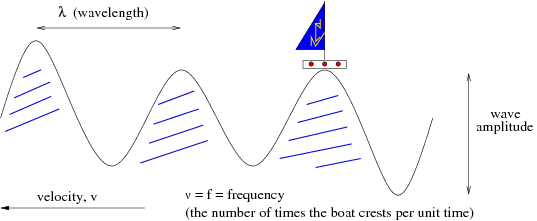
If you went sailing in a boat on the ocean, you would notice that the water was constantly rising and falling in height, making waves. If the weather was calm, you would see smooth, calm, low energy waves. If the weather was stormy, the waves would have been pumped up by the storm into a state of higher energy. You might observe that they were stronger, rose and fell higher (higher amplitude), and that successive waves hit the boat faster and faster (the frequency had increased).

|
| [NMSU, N. Vogt] |
 , as the distance between wave crests (or between
any two identical spots along the waves). The units of wavelength are distance
units, like meters.
, as the distance between wave crests (or between
any two identical spots along the waves). The units of wavelength are distance
units, like meters.
 (or F), the number of times
the boat goes up and down per unit time. The units of frequency are 1/(time),
like 1/second. Sometimes this is written as cycles/second or Hertz
(Hz).
(or F), the number of times
the boat goes up and down per unit time. The units of frequency are 1/(time),
like 1/second. Sometimes this is written as cycles/second or Hertz
(Hz).



What do waves have to do with light?